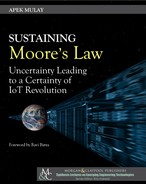0%
63Chapters
0-1Hours read
0kTotal Words
Table of Contents
- Foreword
- Preface
- Acknowledgments
- Impacts of Moore's Law on Human Progress
- From an Unsustainable to a Sustainable Progress of Moore's Law
- Impacts of Semiconductor Business Models on U.S. National Interests
- Introduction
- Economic Reforms Can Defend Against Counterfeit ICs
- Unsustainable Business Models of the U.S. Semiconductor Industry
- Advantages of an Independent Domestic Foundry to the U.S. Fabless Semiconductor Industry
- United Arab Emirates' (UAE's) Track Records on Technology Re-export
- U.S.–UAE Trade Deal
- Conclusion
- References
- Impacts of Semiconductor Business Models on Sustainability
- Macroeconomic Cycles and Business Models for the Progress of Moore's Law
- Introduction
- Examining the Importance of Macroeconomic Cycles and the Semi Market
- A Three-Tier Fabless-Foundry Business Model for the Semiconductor Industry
- Upper Tier: Semiconductor Manufacturing from Top-Notch Wafer Fab
- Lower Tier: The Fabless Semiconductor Businesses
- Middle Tier: The Employee-Sponsored Neo-Cooperative Corporate Sector
- Conclusion
- References
- Would Economics End Moore's Law?
- Design of Supply Chains for the Success of the Internet of Things (IoT)
- The Macroeconomics of 450 mm Wafers
- Moore's Law Beyond 50
- Introduction
- Potential Contributions of the Semiconductor Industry to the Global Economy
- Monopoly Capitalism's Effects on the Progress of Moore's Law
- A Case Study of Monopoly Capitalism in the U.S. Telecommunications Industry
- Other Industries Trying to Imitate Moore's Law
- Redefining Moore's Law at 50
- References
- Macroeconomics of Semiconductor Manufacturing for Emerging Economies
- Introduction
- ``Make in India'': Taking Vision to Reality for Indian Semiconductor Manufacturing
- Can ``Make in India'' Become Sustainable for the Indian Semiconductor Manufacturing Sector with Coming Macroeconomic Changes in the U.S. Economy?
- A Crouching Tiger and Slackening Dragon Teach a Roaring Lion Macroeconomics
- Who is the Lion?
- Who is the Tiger?
- Who is the Dragon?
- What are the King of the Jungle's Upcoming Plans?
- Economic Boom to Bust for the Celtic Tiger
- The Slowing Dragon of China
- What Lessons Can the Lion Learn from the Experiences of the Tiger and the Dragon?
- Make In India Could Collapse Indian Economy
- Conclusion
- References
- The Internet of Things (IoT) Revolution
- An Engagement with Semiconductor Industry Thought Leaders about the Future of the Semiconductor Industry
- Introduction
- A Virtual Sit-Down with Industry Leaders Part I
- A Virtual Sit-Down with Industry Leaders Part II
- A Virtual Sit-Down with Industry Leaders Part III
- A Virtual Sit-down with Industry Leaders Part IV
- A Virtual Sit-Down with Industry Leaders Part V
- A Virtual Sit-Down with Industry Leaders Part VI
- Conclusion
- References
- Author's Biography
